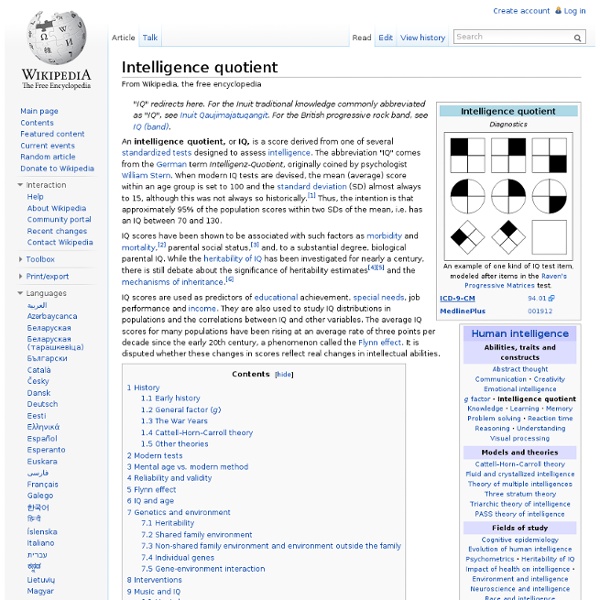



g factor (psychometrics) The g factor (short for "general factor") is a construct developed in psychometric investigations of cognitive abilities. It is a variable that summarizes positive correlations among different cognitive tasks, reflecting the fact that an individual's performance at one type of cognitive task tends to be comparable to his or her performance at other kinds of cognitive tasks. The g factor typically accounts for 40 to 50 percent of the between-individual variance in IQ test performance, and IQ scores are frequently regarded as estimates of individuals' standing on the g factor.[1] The terms IQ, general intelligence, general cognitive ability, general mental ability, or simply intelligence are often used interchangeably to refer to the common core shared by cognitive tests.[2] The existence of the g factor was originally proposed by the English psychologist Charles Spearman in the early years of the 20th century. Mental tests may be designed to measure different aspects of cognition.
Triarchic theory of intelligence Different components of information processing[edit] Schematic illustrating one trial of each stimulus pool in the Sternberg task: letter, word, object, spatial, grating. Sternberg associated the workings of the mind with a series of components. The metacomponents are executive processes used in problem solving and decision making that involve the majority of managing our mind. Sternberg’s next set of components, performance components, are the processes that actually carry out the actions the metacomponents dictate. The last set of components, knowledge-acquisition components, are used in obtaining new information. Whereas Sternberg explains that the basic information processing components underlying the three parts of his triarchic theory are the same, different contexts and different tasks require different kind of intelligence (Sternberg, 2001). Componential / Analytical Subtheory[edit] Sternberg associated the componential subtheory with analytical giftedness. Challenges[edit]
Latent inhibition Theories[edit] The LI effect has received a number of theoretical interpretations. One class of theory holds that inconsequential stimulus pre-exposure results in reduced associability for that stimulus. The loss of associability has been attributed to a variety of mechanisms that reduce attention, which then must be reacquired in order for learning to proceed normally.[2] Alternatively, it has been proposed that LI is a result of retrieval failure rather than acquisition failure.[3] Such a position advocates that, following stimulus pre-exposure, the acquisition of the new association to the old stimulus proceeds normally. Variation[edit] LI is affected by many factors, one of the most important of which is context. Physiology[edit] The assumption that the attentional process that produces LI in normal subjects is dysfunctional in schizophrenia patients has stimulated considerable research, with humans, as well as with rats and mice. Pathology[edit] Low latent inhibition[edit] Notes[edit]
Theory of multiple intelligences The theory of multiple intelligences is a theory of intelligence that differentiates it into specific (primarily sensory) "modalities", rather than seeing intelligence as dominated by a single general ability. This model was proposed by Howard Gardner in his 1983 book Frames of Mind: The Theory of Multiple Intelligences. Gardner articulated seven criteria for a behavior to be considered an intelligence.[1] These were that the intelligences showed: potential for brain isolation by brain damage, place in evolutionary history, presence of core operations, susceptibility to encoding (symbolic expression), a distinct developmental progression, the existence of savants, prodigies and other exceptional people, and support from experimental psychology and psychometric findings. Gardner argues intelligence is categorized into three primary or overarching categories, those of which are formulated by the abilities. The different abilities[edit] Musical–rhythmic and harmonic[edit] Interpersonal[edit]